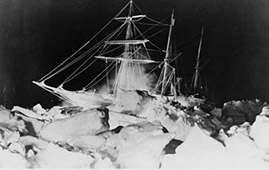James Francis “Frank” Hurley (1885-1962) was an Australian photographer and adventurer(BTW also referred to as “Mad Frank Hurley”). His remarkable photographs document Sir Ernst Shackleton’s ill-fated Imperial Transantarctic Expedition (1914-1916). I very highly recommend that you read Caroline Alexander’s “Endurance,” which is adorned with Hurley’s wonderful photographs. Frank Worsley, Captain of the Endurance, warned Shackleton, leader of the expedition:
“She’s pretty near her end… The ship can’t live in this, Skipper. You had better make up your mind that it’s only a matter of time…what the ice takes, the ice keeps.”

Figure 2 – Another of Hurley’s images of the Endurance trapped in the Antarctic icepack, 1915 in the Wikimedia and in the public domain.
And thus began the greatest sea voyage, 800 miles across furious seas in an open boat, in the history of the world. It is truly the stuff of which legends are made. And Hurley documented it all. I think that you must agree that his photographs are excellent. That he had a gift and an wonderfully artistic eye. Following his Antarctic adventures, Hurley went on to a long and highly productive career in photography and cinema. He was a combat photographer in both World Wars.
I’d like you to consider two more of Hurley’s spectacular images. Shackleton’s return to rescue the sailors he left on Elephant Island (Figure 3) and a combat image “The Battle of Zoonekee” taken by Hurley during World War I (Figure 4). These are both wonderfully executed images and I think really speak to the talent of the photographer..

Figure 4 -Frank Hurley’s “The Battle of Zoonebeke.” Original image is in the collection of the Library of New South Wales and is in the public domain.
Hurley was troubled by the limitations of his media. As we have discussed previously, emulsions of the day were highly sensitive to UV light and, as a result, skies tended to be a boring blur of whiteness. The bulkiness and slowness of early twentieth century cameras made combat photography cumbersome. Remember that earlier war photographers like Matthew Brady tended to photograph the aftermath of battles and camp scenes rather than combat itself.
Both figures 3 & 4 represent manipulations. There is an excellent little video of how and why, in Hurley’s own words, they were done at the Australian Screen Organization’s website. Figure 3 is ambiguous as to whether it truly shows: Shackleton’s return to Elephant Island, as Hurley published it, or his departure. More significantly the dramatic moody sky was added in photo-montage. Similarly, Figure 3 is a montage of three of Hurley’s photographs composited for dramatic effect.
None of this detracts from Hurley as a photographer. However, Australia’s official wartime historian, Charles Bean, who was in charge of the photographic unit, was outraged and declared these images fakes. He demanded Hurley stop making them. I bring these to your attention because they inhabit the grey area between fraud and art. As artistic works all of this manipulation is allowed and acceptable. As photojournalistic images they may be considered to have crossed the ethical line into the realm of fakery. It is a matter of perspective, and you will have to decide for yourselves.


